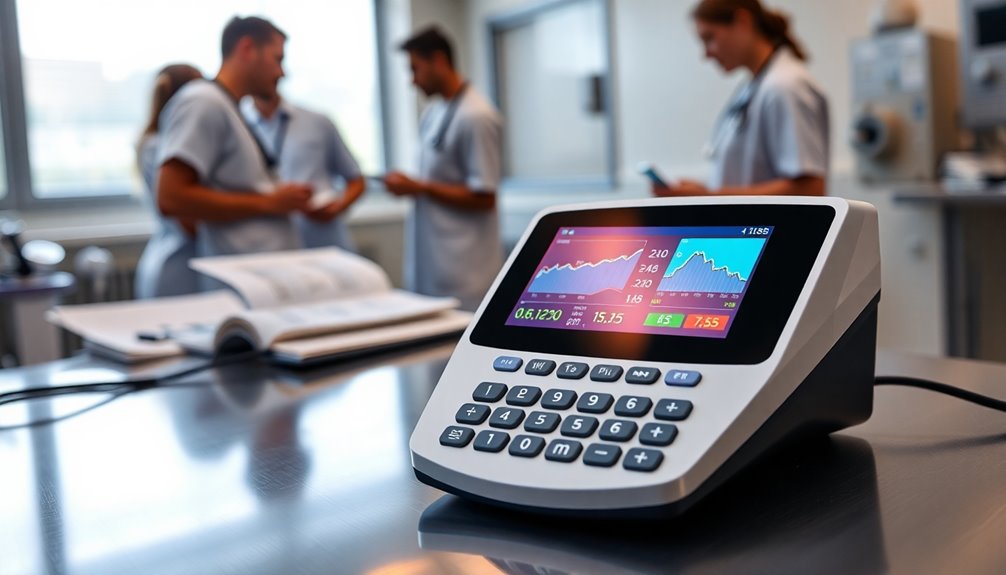The Corrected Sodium Calculator's a crucial tool for managing hyperglycemia and preventing serious complications. It uses formulas like Hillier's or Katz to adjust sodium levels based on blood glucose. When you enter serum sodium and glucose values, it helps clarify whether a patient's sodium is actually low or just appears that way due to fluid shifts. This accurate information is vital for guiding treatment decisions in diabetes care, ensuring patient safety, and reducing mortality risks. By utilizing this tool, you can significantly enhance clinical decision-making. Stick around and discover even more about its life-saving benefits!
Key Takeaways
- Corrected Sodium Calculators accurately adjust sodium levels in hyperglycemic patients, preventing misdiagnoses and guiding effective treatment strategies.
- Utilizing Hillier's formula, these calculators provide critical insights into sodium levels, especially when glucose exceeds 400 mg/dL.
- Quick access to corrected sodium values enhances clinical decision-making, improving safety and patient outcomes in conditions like DKA and HHS.
- User-friendly interfaces allow healthcare providers to efficiently calculate and understand sodium corrections, streamlining workflow and communication.
- Ongoing advancements in these tools promise improved accuracy and faster corrections, potentially reducing mortality rates in severe hyponatremia cases.
Understanding Hyperglycemia and Sodium

Understanding hyperglycemia and sodium levels is crucial, especially when you're evaluating patients with diabetes. When blood glucose levels rise, serum osmolarity increases because glucose acts as an effective osmole. This shift causes water to move from inside the cells to the extracellular space, leading to a dilution of extracellular sodium. Although the total body water and actual sodium amount remain unchanged, the serum sodium concentration appears lower due to this dilution effect.
As glucose levels exceed normal ranges, the dilution becomes more pronounced, creating a misleading impression of hyponatremia. It's important to remember that this situation doesn't reflect true hyponatremia but rather a temporary response to hyperglycemia. When blood glucose normalizes, this dilution effect reverses, restoring accurate sodium levels. The increase in serum osmolarity due to hyperglycemia necessitates careful monitoring of sodium levels to prevent misinterpretation of results.
In clinical practice, understanding this mechanism is essential for avoiding misdiagnoses. If sodium levels aren't corrected, you could mistakenly treat a patient for hyponatremia, leading to inappropriate interventions. Always consider both glucose and sodium levels together to ensure a comprehensive evaluation and appropriate management of potential complications related to hyperglycemia.
Steps for Calculating Corrected Sodium

To accurately calculate the corrected sodium level, you'll need to gather essential data first. Start with the serum sodium level, measured in mEq/L or mmol/L, and the blood glucose level, determined in mg/dL or mmol/L. Make sure the units of measurement are consistent. Next, consider the patient's clinical context, particularly if there's hyperglycemia or other electrolyte imbalances. Understanding that hyperglycemia causes water to shift from intracellular to extracellular space is crucial for accurate sodium measurement.
Once you have this data, you can apply either the Hillier Formula or the Katz Formula. For the Hillier Formula, use: corrected sodium level = serum Na⁺ + 0.024 × (serum glucose − 100). If you opt for the Katz Formula, it's: corrected sodium level = serum Na⁺ + 0.016 × (serum glucose − 100). Substitute your serum sodium and glucose values into the chosen formula and perform the calculation.
Alternatively, you can use online calculators designed for sodium correction. Input the serum sodium and glucose levels, and let the calculator do the work. Finally, interpret the corrected sodium level to understand the patient's true sodium status, guiding your treatment decisions.
Overview of Corrected Sodium Formulas

Corrected sodium formulas provide a systematic approach to adjusting sodium levels in the context of hyperglycemia. The Katz Formula, developed in 1973 by Murray A. Katz, was the first to address hyperglycemia-induced hyponatremia, calculating corrected sodium with the equation: measured sodium in mEq/L + 0.016 × (serum glucose in mg/dL – 100). This formula used a correction factor of 1.6 mEq/L for every 100 mg/dL increase in serum glucose.
In 1999, Teresa A. Hillier and her team updated this approach with the Hillier Formula. This newer formula employs a higher correction factor of 0.024 × (serum glucose in mg/dL – 100) and is particularly effective for glucose levels above 400 mg/dL, resulting in a correction factor of 2.4 mEq/L. Accurate sodium correction is essential for patient management in hyperglycemia, as misinterpretation of sodium levels may lead to inappropriate treatments.
Both formulas highlight the physiological mechanism where high blood glucose increases extracellular fluid osmolality, causing water to shift from cells, which dilutes serum sodium. Understanding these formulas is crucial for interpreting sodium levels accurately, especially in managing patients with diabetes and hyperglycemia, ensuring proper treatment and avoiding misinterpretation of sodium status.
Clinical Significance of Corrected Sodium

Recognizing the clinical significance of corrected sodium levels is essential in managing hyperglycemic patients. High glucose levels can falsely lower measured sodium levels, complicating your assessment. By applying correction factors, you can adjust sodium levels and gain a clearer picture of the natremia situation. This is crucial, as hyperglycemia can mask underlying hyponatremia or hypernatremia, leading to potential mismanagement.
Corrected sodium levels play a vital role in tailoring fluid therapy for conditions like diabetic ketoacidosis (DKA) and hyperosmolar hyperglycemic state (HHS). They help prevent rapid shifts in osmolality, reducing the risk of cerebral edema. Moreover, corrected sodium levels serve as better indicators of clinical outcomes than measured sodium levels in hyperglycemic patients. The sodium correction factor for hyperglycemic diabetic dogs has been identified as 1.6 mEq/L, aiding in accurate sodium level assessments.
Severe corrected hyponatremia and hypernatremia can elevate mortality risks, making it essential to monitor these levels closely. By understanding the implications of corrected sodium, you can better predict complications and adjust treatment strategies accordingly. Following guidelines for correction rates can also mitigate risks associated with rapid changes. In summary, accurate corrected sodium assessment can significantly influence treatment outcomes and improve patient safety.
Available Tools and Calculators

Understanding the importance of corrected sodium levels opens the door to various tools and calculators that make this process easier. You have multiple online calculators at your disposal, like the Corrected Sodium Calculator by Calculator Academy, which uses Hillier's formula for accurate results. The Sodium Correction for Hyperglycemia Clinical Calculator allows you to calculate in both US Customary and Metric units, while Omnicalculator's option provides flexibility with Katz's and Hillier's formulas.
MDApp's Corrected Sodium Calculator also employs both formulas and guides you through the calculations step by step. For those focused on perinatology, Perinatology.com's calculator incorporates both Katz and Hillier's methods, ensuring comprehensive care. Corrected Sodium is essential for appropriate treatment decisions, especially in patients with diabetes and hyperglycemia.
These calculators require input of the measured sodium level and blood glucose level, delivering the corrected sodium level in the same units. Many include additional features, like glucose unit conversion tools and options to print or share results. They often come with educational resources that explain the context behind the calculations, enhancing your understanding. With user-friendly interfaces, these tools empower you to make informed clinical decisions regarding sodium correction and treatment planning.
Physiological Mechanism of Sodium Correction

In hyperglycemia, the physiological mechanism behind sodium correction revolves around fluid shifts and dilution effects. When glucose levels rise, extracellular fluid osmolality increases, prompting water to move from inside cells to the extracellular space. This shift happens because glucose enters cells, displacing water. As a result, serum sodium concentration appears to fall due to dilution in the extracellular fluid, leading to a temporary state of hyponatremia. This condition can also result from various factors including excess total body water, which highlights the importance of understanding the underlying causes of sodium changes.
To accurately assess sodium levels, you can use correction formulas like the Katz or Hillier formulas, which adjust for glucose-induced hyponatremia. These calculations help clarify true natremia, especially when glucose levels exceed 400 mg/dL. The apparent hyponatremia is transient and resolves as glucose levels normalize, revealing that there's no actual sodium deficit—just fluid redistribution.
Understanding this mechanism is crucial in clinical settings to prevent misdiagnosis of true hyponatremia. By recognizing the role of hyperglycemia in sodium correction, you can avoid unnecessary treatments and ensure appropriate management of patients facing hyperglycemic crises. Corrected sodium values enable you to make informed decisions in critical care and emergency situations.
Importance in Diabetes Management

Managing diabetes effectively hinges on accurate sodium assessment, especially when dealing with hyperglycemia. High glucose levels can lead to false readings of hyponatremia, which may misguide treatment decisions. Using a corrected sodium calculator helps you adjust sodium levels based on glucose, ensuring you interpret serum sodium results accurately. This distinction between true hyponatremia and pseudohyponatremia is crucial for appropriate management.
When developing treatment plans, the calculator influences your choice to administer insulin or other therapies to address hyperglycemia. It also guides whether sodium correction infusates are necessary, allowing you to monitor treatment effectiveness through tracked corrected sodium levels. This precision prevents unnecessary sodium supplementation in cases of pseudohyponatremia and keeps your focus on normalizing glucose levels. Furthermore, understanding the sodium alteration mechanisms in hyperglycemia is essential for making informed decisions regarding patient care.
In diabetic ketoacidosis (DKA) management, monitoring corrected sodium levels is vital. It helps assess the risk of cerebral edema and guides fluid and electrolyte administration. By ensuring corrected sodium levels rise as glucose levels fall, you can confirm treatment efficacy and stay alert to potential complications. Ultimately, accurate sodium assessment enhances your clinical judgment, prioritizing patient care and facilitating effective communication within healthcare teams.
Real-World Applications of Calculators

Today, healthcare professionals leverage corrected sodium calculators in various clinical settings to enhance decision-making and patient outcomes. These calculators integrate seamlessly into medical processes, guiding you in diagnosing and treating patients effectively. By assessing the risk of conditions like pseudo hyponatremia, you can interpret lab results more accurately, ensuring adherence to established clinical guidelines.
Corrected sodium calculators help you achieve precise sodium level assessments, correcting for dilutional effects caused by high glucose levels. This accuracy prevents misdiagnoses, allowing you to implement timely interventions that can significantly improve patient outcomes. With features like error warnings and normal value checks, these tools reduce the chance of mistakes, enhancing patient safety. Moreover, the predictive performance of clinical calculators is crucial for understanding patient risk factors and tailoring treatment approaches.
Furthermore, medical calculator apps streamline your workflow by providing instant access to essential calculations. They offer convenience, enabling quick, informed decisions even in challenging settings. The ability to customize calculator lists for frequently used tools enhances efficiency, allowing you to focus on delivering quality care. By simplifying complex medical calculations, corrected sodium calculators play a vital role in improving healthcare efficiency and ensuring better survival rates, especially in critical care environments.
Future of Sodium Correction Tools

As advancements in sodium correction tools continue to unfold, healthcare professionals can expect significant improvements in accuracy and efficiency. The integration of updated correction factors like the Hillier and Katz formulas will help you refine your approach to managing hyperglycemia. With these equations, you can ensure precise calculations while considering blood glucose levels, crucial for preventing false interpretations of hyponatremia.
Automated calculators will revolutionize your daily practice, streamlining the correction process with real-time updates and user-friendly interfaces. These tools will allow you to easily input patient data and receive corrected sodium levels, all while maintaining compatibility with various glucose and sodium measurement units. Furthermore, the findings of recent studies indicate that faster correction rates can significantly reduce mortality rates in patients with severe hyponatremia.
Moreover, ongoing research may lead to revisions in treatment protocols, emphasizing the benefits of faster correction rates. As you monitor the long-term effects of these methods, you'll also witness a reduction in mortality rates and shorter hospital stays for your patients.
Ultimately, the future of sodium correction tools is bright, promising better clinical outcomes and enhanced patient comfort. By embracing these innovations, you'll not only improve your practice but also contribute to advancing patient care in the medical field.
Frequently Asked Questions
How Does Dehydration Affect Sodium Levels?
Dehydration significantly impacts sodium levels in your body. Depending on the type, isotonic dehydration lowers both fluid and sodium levels but keeps serum sodium normal. Hypotonic dehydration decreases sodium levels, while hypertonic dehydration raises them, causing cells to shrink. If you experience fluid loss and replace it with hypotonic solutions, you risk hyponatremia. It's crucial to monitor your sodium levels to maintain proper hydration and overall health.
Can Medications Influence Sodium Correction Calculations?
Yes, medications can definitely influence sodium correction calculations. Certain drugs, like thiazide diuretics and SSRIs, can cause hyponatremia, complicating your efforts to correct sodium levels. You need to monitor serum sodium closely and adjust your correction rates as needed. If you're on medications that affect vasopressin, you might require a slower correction to avoid complications like osmotic demyelination syndrome. Always consider medication effects when managing sodium levels effectively.
What Are the Symptoms of Pseudohyponatremia?
You won't find specific symptoms for pseudohyponatremia, as it's an artifact from blood sample processing. Even though the sodium measurement appears low, your actual plasma sodium concentration is normal, meaning you won't experience symptoms directly related to it. Instead, focus on other underlying conditions like severe hyperlipidemia or hyperproteinemia, which could be causing the discrepancy. Always ensure to differentiate it from true hyponatremia to avoid complications.
Is Corrected Sodium Applicable in All Patient Populations?
Corrected sodium isn't universally applicable to all patient populations. You need to consider individual factors like age, sex, and underlying conditions. For instance, children and elderly patients may require different correction methods due to their varying body water percentages. Additionally, conditions like hyperglycemia can affect sodium levels, necessitating specific formulas. Always consult a healthcare provider to ensure the correction approach aligns with your unique clinical circumstances and to prevent potential complications.
How Often Should Sodium Levels Be Monitored in Diabetics?
You should monitor sodium levels daily in diabetics, especially if they experience significant fluctuations. Hyperglycemia can dilute sodium, leading to inaccurate readings. Regular checks help you adjust fluid intake and medications effectively, preventing complications. If you're using insulin, you might need more frequent monitoring, as it directly impacts glucose and sodium levels. Keeping sodium within the normal range is crucial for overall health, so stay vigilant and proactive in your monitoring efforts.
Conclusion
In conclusion, understanding and calculating corrected sodium is crucial for effective diabetes management and patient care. By using the right tools and formulas, you can ensure accurate assessments that ultimately save lives. These calculators not only simplify the process but also enhance clinical decision-making. As technology evolves, the future of sodium correction tools looks promising, making it easier for healthcare providers to deliver optimal care. Stay informed and embrace these vital resources in your practice!









